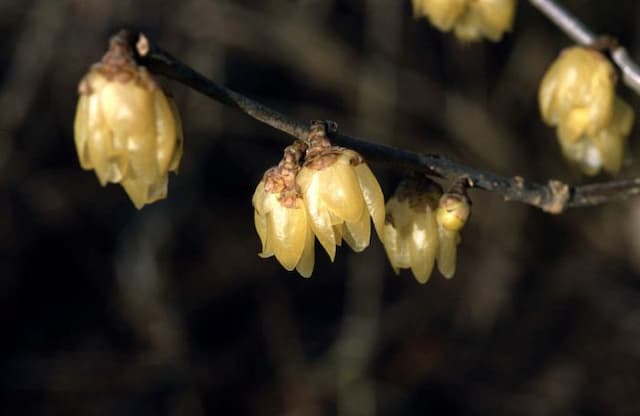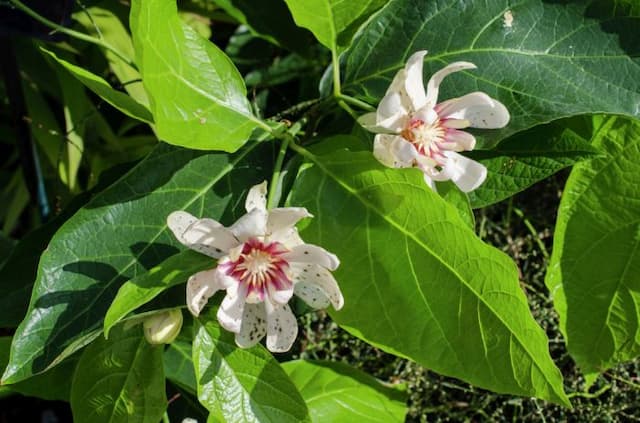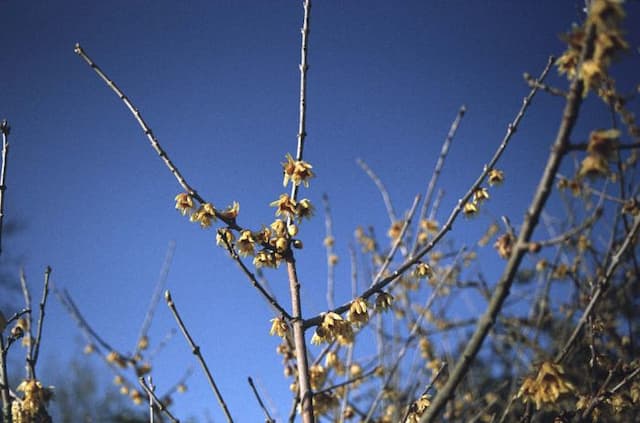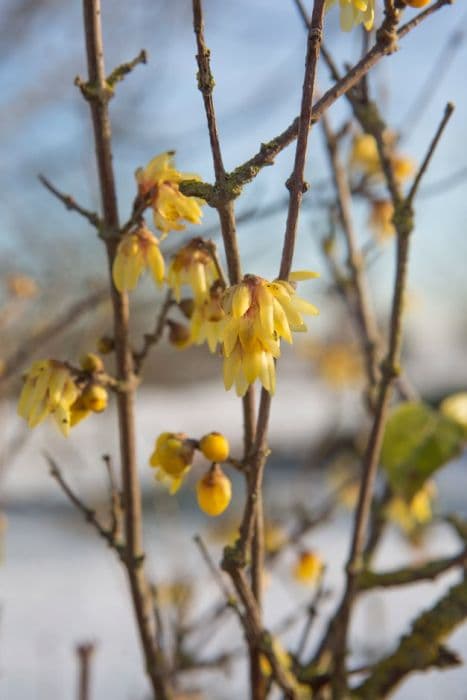Sweetshrub Calycanthus 'Aphrodite'

ABOUT
The Calycanthus 'Aphrodite', also known as the Sweetshrub 'Aphrodite', is a captivating deciduous shrub that flaunts large, reddish-pink to maroon flowers. These flowers are quite striking with their numerous, spirally arranged petals, which emit a rich, fruity fragrance reminiscent of apples, strawberries, or pineapples, depending on the nose of the beholder. The blossoms have a magnolia-like appearance and are prominently displayed above the foliage during the blooming season. The leaves of Sweetshrub 'Aphrodite' are glossy and dark green, forming an attractive, dense backdrop to the flowers. In autumn, the foliage may transition to golden-yellow hues, adding seasonal interest to the garden landscape. The plant has a bushy, rounded habit with elegantly arching branches that give it a lush, full look. Its smooth, gray-brown bark provides a pleasant contrast against the vibrant green of the leaves and the depth of the flower colors. Throughout the seasons, the Sweetshrub 'Aphrodite' offers continual aesthetic appeal, from the emergence of its flowers in late spring or early summer to the autumnal color change and the textural interest of its winter silhouette after the leaves have fallen.
About this plant
 Names
NamesSynonyms
Sweetshrub, Aphrodite Sweetshrub, Strawberry Bush.
Common names
Calycanthus 'Aphrodite'.
 Toxicity
ToxicityTo humans
The plant commonly known as Sweetshrub is not widely recognized as toxic to humans. However, as with many plants, it may cause mild stomach upset if ingested in large quantities. Symptoms are not commonly reported and severe toxicity is unlikely, but it is advised not to consume any part of the plant.
To pets
Sweetshrub is not specifically listed as toxic to pets such as cats and dogs. However, the general rule with ornamental plants is to prevent pets from ingesting them. While no significant toxicity is expected, ingestion might result in mild gastrointestinal upset. If a pet ingests a large amount of the plant and displays symptoms, it is advisable to consult a veterinarian.
 Characteristics
CharacteristicsLife cycle
Perennials
Foliage type
Deciduous
Color of leaves
Green
Flower color
Red
Height
6 feet (1.83 meters)
Spread
6 feet (1.83 meters)
Plant type
Shrub
Hardiness zones
5
Native area
North America
Benefits
 General Benefits
General Benefits- Aesthetic Appeal: The Carolina allspice 'Aphrodite' offers large, attractive, red magnolia-like flowers that add visual interest to the garden.
- Fragrant Flowers: Known for its fragrant blooms, it emits a sweet, fruity scent that can enhance the sensory experience in a garden setting.
- Seasonal Interest: This plant has a long blooming season, typically from early summer into autumn, providing extended color and interest.
- Wildlife Attraction: The flowers of Carolina allspice 'Aphrodite' attract pollinators such as butterflies and bees, promoting biodiversity.
- Drought Tolerance: Once established, it has good tolerance to drought, making it a low-maintenance option for water-conservation landscapes.
- Adaptability: It adapts well to a variety of soil types, though it prefers well-drained soils, making it versatile for different garden settings.
- Low Maintenance: This plant generally requires minimal pruning and care, which can save time and effort for gardeners.
 Medical Properties
Medical PropertiesThis plant is not used for medical purposes.
 Air-purifying Qualities
Air-purifying QualitiesThis plant is not specifically known for air purifying qualities.
 Other Uses
Other Uses- Calycanthus 'Aphrodite', often known as Sweetshrub, can be used in the creation of natural dyes. The bark and flowers may be utilized in various stages of decay to produce dyes for textiles.
- The wood of Sweetshrub can be used in small-scale woodworking projects. Its fine grain makes it suitable for crafting intricate items such as inlays and small boxes.
- Sweetshrub can be utilized in landscape design not only for its aesthetics but also to create privacy screens in gardens due to its dense foliage.
- The fragrance of Sweetshrub flowers can be captured in potpourris. Dried flowers retain their scent and can be used in sachets to freshen up closets and drawers.
- As an educational tool, Sweetshrub can be used in schools and botanical gardens to teach plant propagation techniques such as softwood cuttings.
- The leaves of Sweetshrub can serve as a natural pest deterrent in gardens due to their spicy scent, potentially repelling certain insects from more sensitive plants.
- Sweetshrub could play a role in sensory gardens, as its rich fragrance and textured leaves provide sensory stimulation for visitors, especially those with visual impairments.
- In artistic pursuits, Sweetshrub flowers and branches can be incorporated into floral arrangements and used as inspiration or actual components in botanical art.
- The plant's dense habit provides habitat for wildlife. Birds may use the shrub for nesting, and its flowers can attract pollinators like bees and butterflies.
- Sweetshrub twigs and branches can be used in rustic crafts, such as making wreaths or as part of decorative displays in country-style home decor.
Interesting Facts
 Feng Shui
Feng ShuiThe Sweetshrub is not used in Feng Shui practice.
 Zodiac Sign Compitability
Zodiac Sign CompitabilityThe Sweetshrub is not used in astrology practice.
 Plant Symbolism
Plant Symbolism- Love and Romance: Named after Aphrodite, the Greek goddess of love and beauty, this plant often symbolizes all facets of love, from physical attraction to deep affection.
- Passion: The luscious red of the 'Aphrodite' Sweetshrub blooms evokes strong feelings of passion and desire, similar to the emotions often associated with the goddess it is named after.
- Beauty and Attraction: Just as Aphrodite is renowned for her stunning appearance, the 'Aphrodite' Sweetshrub symbolizes beauty and the ability to attract others.
- Rarity and Exclusivity: As this cultivar of Sweetshrub is a unique and cultivated variety, it can also come to represent something rare or exclusive, possibly referring to a rare beauty or a unique quality in a person.
 Water
WaterSweetshrub 'Aphrodite' should be watered deeply and thoroughly to ensure the root zone is moist, typically requiring about 1 to 1.5 inches of water per week depending on the soil type and weather conditions. During the first growing season, it is important to establish a deep and extensive root system, so water more frequently, like twice a week. Once established, sweetshrub can tolerate some dryness between watering sessions, so you can reduce frequency to once a week or once every two weeks, bearing in mind to adjust according to rainfall, temperature, and humidity levels. In hot, dry periods, you may need to water more often to prevent stress. It’s better to water in the early morning to reduce evaporation and ensure that the plant has sufficient moisture throughout the day.
 Light
LightSweetshrub 'Aphrodite' thrives best in full sun to partial shade conditions. The ideal spot provides it with at least four to six hours of direct sunlight each day, preferably the morning light, which is less intense than the afternoon sun. In hotter climates, some afternoon shade can be beneficial to prevent scorching of the leaves.
 Temperature
TemperatureSweetshrub 'Aphrodite' prefers temperatures in the range of 60 to 85 degrees Fahrenheit for optimal growth. It can tolerate a minimum temperature of around 0 degrees Fahrenheit, but any colder may cause damage to the plant. The maximum temperature it can withstand is approximately 95 degrees Fahrenheit, beyond which the plant may experience stress.
 Pruning
PruningSweetshrub 'Aphrodite' is pruned to shape the plant, remove any dead or diseased wood, and encourage bushier growth. Prune in late winter or early spring before new growth begins, as this is when the plant is still dormant. Thinning out some of the older stems encourages more flowers and vigorous new growth. Remove only about a third of the wood in a single season to keep the plant healthy and well-shaped.
 Cleaning
CleaningAs needed
 Soil
SoilSweetshrub 'Aphrodite' thrives in well-draining, loamy soil enriched with organic matter, with an ideal pH range of 6.0 to 7.0. A mixture of two parts garden soil, one part well-rotted compost or peat moss, and one part perlite or sand is recommended for optimal growth and blooming.
 Repotting
RepottingSweetshrub 'Aphrodite' is not commonly grown in containers and thus does not have a specific repotting schedule. It is typically planted directly into the garden, where it can remain without repotting. If grown in a container, repot every 2-3 years or when it becomes root-bound.
 Humidity & Misting
Humidity & MistingSweetshrub 'Aphrodite' is adaptable to ordinary outdoor humidity levels and does not require any special humidity conditions. It will thrive in the natural humidity found in its growing regions without the need for additional humidity adjustments.
 Suitable locations
Suitable locationsIndoor
Place Sweetshrub 'Aphrodite' in bright, indirect light indoors.
Outdoor
Plant in sun to part shade, provide space, mulch, and water.
Hardiness zone
5-9 USDA
 Life cycle
Life cycleSweetshrub 'Aphrodite' begins its life cycle with seed germination, typically occurring in spring or early summer. Once the seedling emerges and establishes itself, it enters a period of rapid vegetative growth, developing a strong root system and foliage. In subsequent years, the shrub continues to mature, growing larger and developing its characteristic structure with multiple stems. As it reaches maturity, usually within a few years, 'Aphrodite' produces fragrant, magnolia-like red flowers in late spring to early summer, attracting pollinators to facilitate reproduction. After pollination and fertilization, the plant produces fruits that mature by late summer or fall, dispersing seeds to complete the cycle. In its mature phase, which can last many years, the shrub enters a cycle of seasonal growth, maintenance, and dormancy, with pruning and environmental factors influencing its vigor and lifespan.
 Propogation
PropogationPropogation time
Spring-Early Summer
Calycanthus 'Aphrodite', commonly known as Aphrodite Sweetshrub, is best propagated by softwood cuttings taken in late spring to early summer. To propagate by cuttings, start by selecting a healthy, non-flowering stem and making a cut about 4 to 6 inches (10 to 15 cm) long, just below a leaf node. Remove the leaves from the lower half of the cutting, dip the cut end in rooting hormone to encourage root growth, and insert it into a pot filled with a well-draining soil mix. Keep the soil consistently moist and cover the cutting with a plastic bag to maintain high humidity around it. Roots typically develop within a few weeks, and once they are established, the new Aphrodite Sweetshrub plant can be transplanted to its permanent location.




